Installing SLP Exhaust HeadersAlthough not perfect, the SC Riviera has a pretty good exhaust system for an OEM set-up. From the engine, exhaust gases flow into a pair of cast iron manifolds, through a 2.5" down pipe, a catalytic converter, resonator, a few feet of 2.25" straight, and finally a T-split to dual 1.875" pipes, two mufflers, and oval tips. Not ideal, but better than your average car.
For running CAI and SC pulleys down to 3.4", you can get away with using a completely stock exhaust system if you tune for extra fuel. Even high-lift rockers can be ran with a stock exhaust, but this is where you begin to see some limitation in output. As you increase air flow to the engine, the exhaust now becomes the restrictive area. A larger diameter down pipe and/or a set of PEMs (ported exhaust manifolds) will help by letting out more air to lower boost somewhat, so you can expect a some reduction in KR. But larger down pipes and PEMs can only do so much. If you're planning to seriously modify your car, exhaust
headers may be a better choice.
Headers increase exhaust flow in two ways. First, tube diameters up to the catalytic converter are increased. The 3" diameter flex-pipe used with
SLP headers, for example, replaces the 2.5" OEM down pipe. 1.625" header primaries have a larger combined volume than the stock manis. Bigger pipes flow more air, and this is most important near the engine where exhaust gases are hotter and faster-moving than downstream. Another way
headers improve exhaust flow is by spacing out the arrival time of each cylinder's exhaust pulses so they don't interfere with one another, reducing back pressure in the system. You cannot get this benefit by porting/polishing a stock manifold. This is the limitation of using PEMs.
Do you need
headers? If you want to go as far as installing a cam, the answer is probably yes. With all the extra air flowing through the engine, you'll need a way to let it out. Even if you're not planning a cam,
headers will improve the performance of an engine with high-lift rockers, though not quite as much. If you only plan to run a 3.4" pulley with intake and a mild tune, maybe
headers aren't for your car. Not that they donn't work, but the power gained might be less than you'd expect for the amount of time/money spent.
Consider the price. Good
headers aren't cheap. The set of stainless
SLP Performance headers used for this write-up will run about $900 if you do the work yourself.
TOG headers are another stainless option for about the same price (here's a
link to a TOG install). New on the scene is a brand called
Pacesetter, which sells for only $350. Keep in mind these cheaper
headers use a slightly different design and have not yet been tested on a Riviera. Also, they are made of uncoated mild steal, so likely will not last like the SS versions. Ceramic coating for the Pacesetters is available for an additional cost. Also new to the market are Chinese-made knock-offs of the SLP design for less than $250 on ebay. Like the SLPs, they are stainless, but like the Pacestters they are not coated.
Important note: installing
headers will change your car's character somewhat. Put simply, thin-walled
headers are not as quiet as the heavier OEM cast-iron manifolds, so they will resonate when you get on them, and vibration can be both felt and heard inside/outside the car. If you value your Riv's luxury car feel, you may want to consider PEMs instead, or find a front header (or PowerLog) and keep the rear manifold in place. Another consideration is that most
headers are considered off-road equipment and may not pass inspection in some states. If you're unsure of the the laws in your area, check with your local authority.
Deciding to move forward? A great choice for exhaust
headers are manufactured by
SLP Performance, makers of optional performance packages used by GM. Constructed of .055" wall 409 stainless steel using CNC mandrel bends with a built-in 3" flex pipe, these
headers are made in USA and Jet-Hot aluminum/ceramic coated inside and out. Truly a top-notch product that fits the Riviera, produces noticeable HP gains, and is proven to last whether you're racing your car or driving it every day. Available through
INTENSE Racing, here's what you get:
[img]

[/img]
Parts included with the
SLP set ($699.99): front side header, back side header/collector/flex pipe, crossover pipe, & O2 sensor wire/connector.
Included with the
SLP installation kit ($89.99): (2) header gaskets, (2) clamps, (other accessories intended for W-body installation, not used).
While possible to reuse the existing studs,
ARP header bolts are recommended ($29.99), and if you intend to delete the catalytic converter, the
INTENSE stainless steel race pipe ($49.99) is a perfect fit, or any 3.5" OD pipe will work. A
Flowmaster venturi cone can be used to join the race pipe to the existing system. If you're going to run a cat converter, chose a high-flow type ($75-150) to replace the stock unit.
Since we are using
headers designed for the W-Body cars (GTP, GS), the transmission filler tube must be replaced with one from a Series II-equipped Pontiac GTP. This can be obtained for $10 from Ed Morad or a local salvage yard.
Tools you'll need are a good set of wrenches, a socket set, and a Sawzall will come in handy. And it really helps to have a second hand to help out. I had a friend working up top while I was down below... made the job much easier. Plus, if you need to go to the parts store...
Give yourself an entire day to do the job. Depending on your skill level, and your luck, you could be done in time for dinner. Just in case, it might be better to start Saturday vs. Sunday if you need the car for the work week. You want to be able to take your time and get it right.
STEP 1: Apply PB Blaster penetrating lubricant generously to all exhaust manifold studs/bolts and down pipe flange the night before starting the job.
STEP 2: Before removing the manifolds, drive the car until warmed up, then begin work as soon as it's cool enough to access the bolts. Reapply PB Blaster as in STEP 1.
STEP 3: Disconnect the battery. It's under the rear seat cushion. Just lift it up, loosen the negative terminal, and get it over with. If you skip this step, don't say I didn't warn you...
STEP 4: Remove the engine cover and oil filler neck.
STEP 5: Disconnect the front and rear ignition wires. Remove the plastic bracket and relocate the front/rear wires out of the way.

STEP 6: Remove front manifold heat shield (temporarily).
STEP 7: Loosen manifold bolts on front side and two bolts on crossover pipe. Remove front manifold.
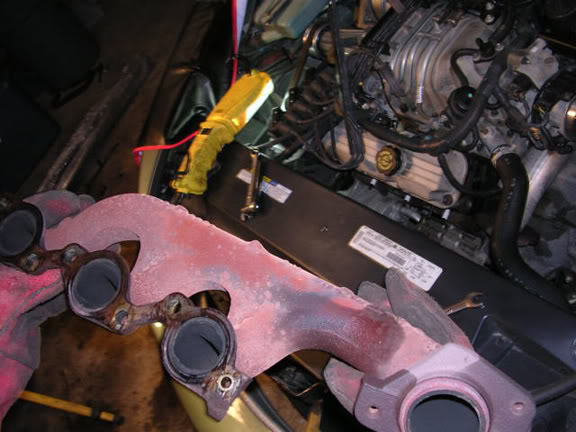
STEP 8: Remove front manifold gasket and clean up gasket area.
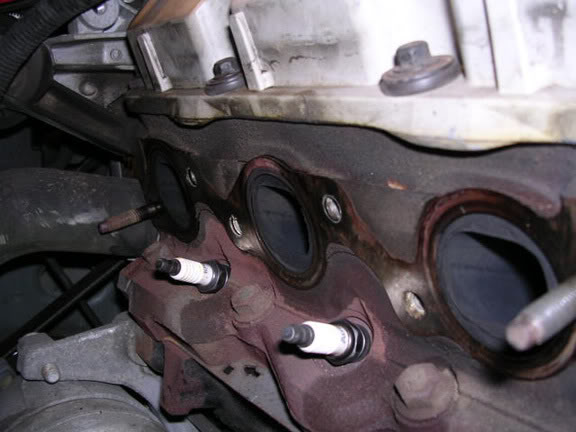
STEP 9: Jack up the front end of the car and support with jack stands. You need to raise the car enough so you can get under the car and work. You do not need to remove the front wheels.
STEP 10: Loosen two bolts on down pipe flange and disconnect.

STEP 11: Using a hack saw or Sawzall, cut the stock pipe close to the cat converter.
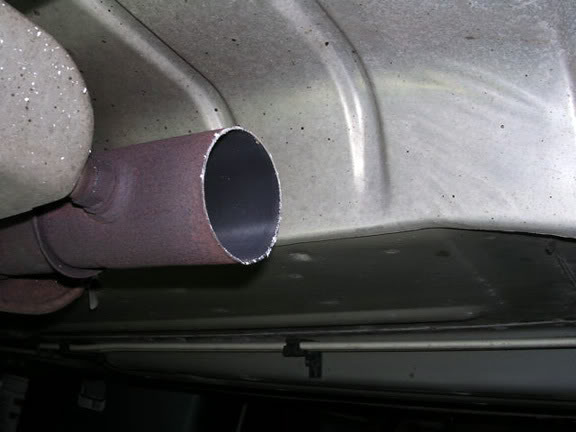
STEP 12: Loosen two bolts on rear crossover connection and disconnect.
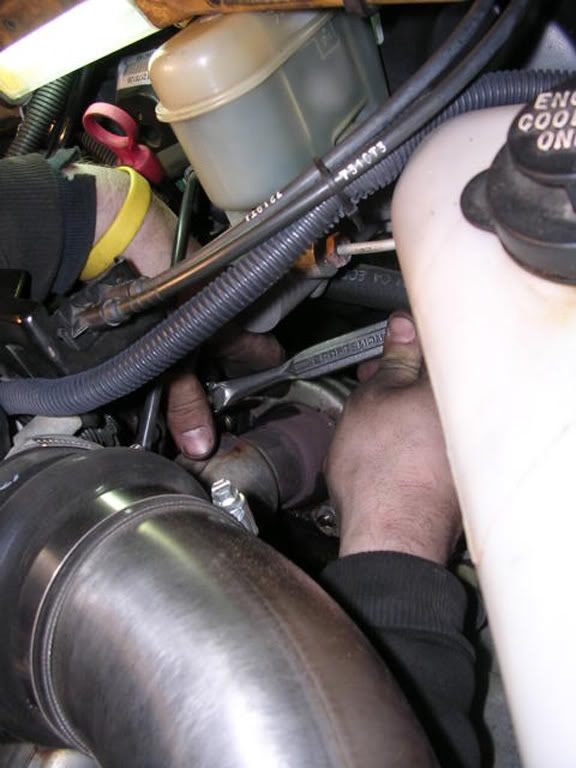
STEP 13: Remove crossover pipe.
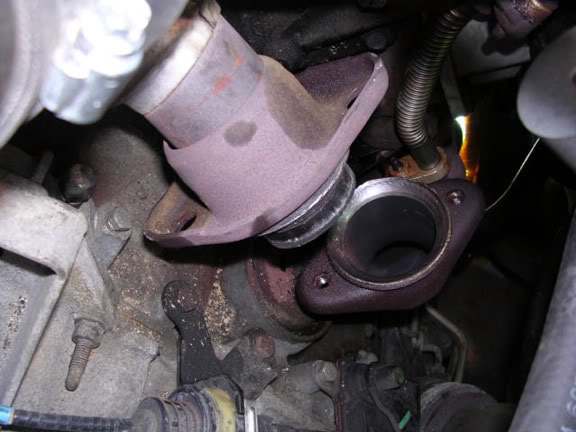
STEP 14: Loosen and remove EGR assembly (temporarily).
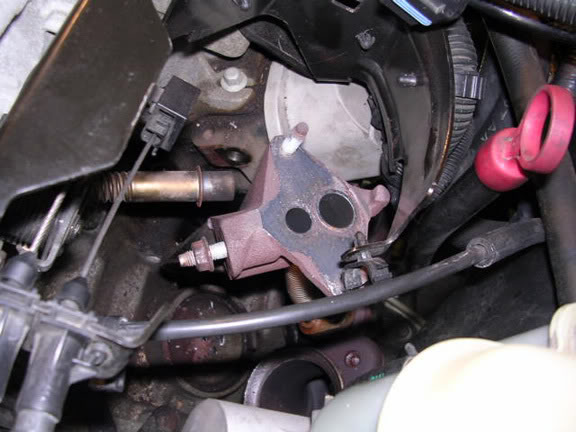
STEP 15: Disconnect front O2 sensor wire connector. Replace with new wire/connector.
STEP 16: Loosen screw and remove transmission oil filler tube & dipstick.
STEP 17: Loosen manifold bolts on back side. Remove rear manifold (should slide out the bottom). here's a picture of the old manifolds next to the
headers:
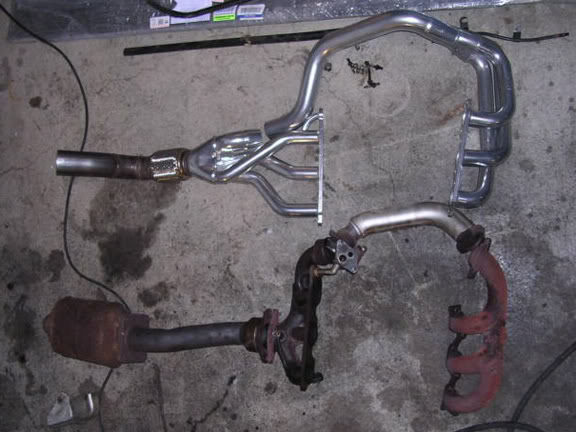
STEP 18: Remove rear manifold gasket and clean up gasket area.
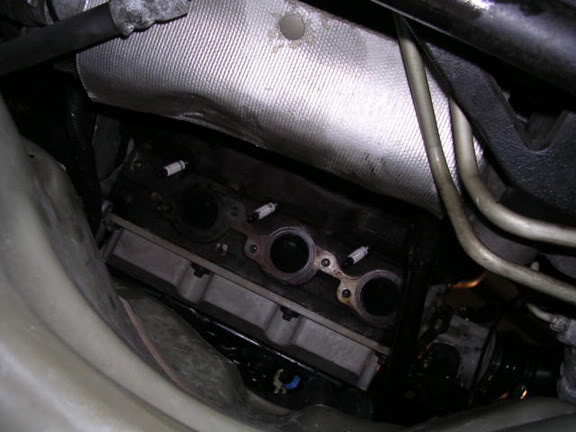
STEP 19: Remove O2 sensor from rear manifold; install into rear header. This is obviously a good time to replace with a new O2 sensor if yours has lots of miles on it. Use only an AC sensor sold at dealerships.
STEP 20: Install rear header w/ gasket. Tighten bolts to 22 lb-ft.
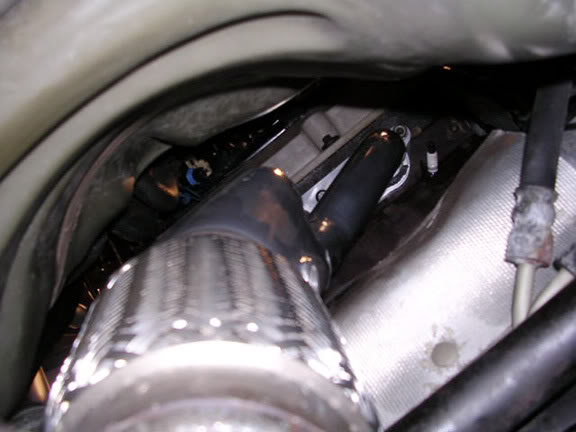
STEP 21: Install GTP transmission tube & dipstick.
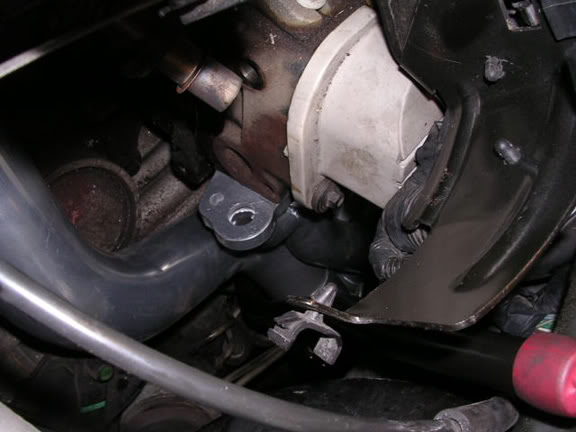
STEP 22: Verify flex pipe and stock exhaust pipe are aligned and there is room for race pipe/cat covert to fit. Trim pipes if necessary. If installing cat, install it with clamps, then skip to STEP 25.

STEP 23: Insert reducer pipe into stock exhaust. Tap into place.
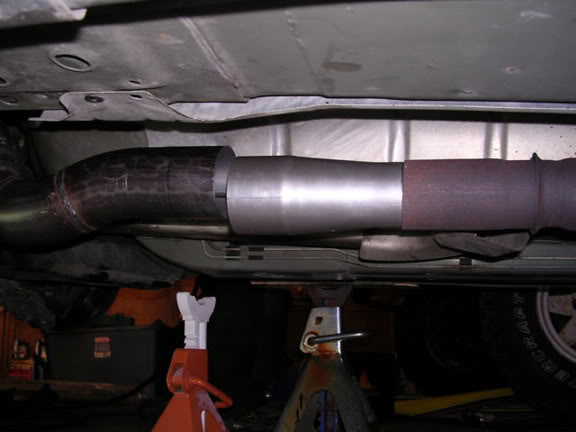
STEP 24: Disconnect rear exhaust hangers. Pull system toward rear and Insert race pipe (may need two people to do this). Clamp pieces in place. Be careful! Edges of pipe and clamps are sharp.
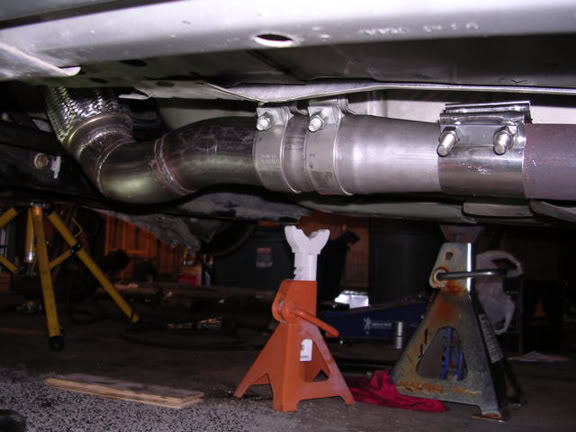
STEP 25: Reconnect front O2 sensor w/ new wire connector.
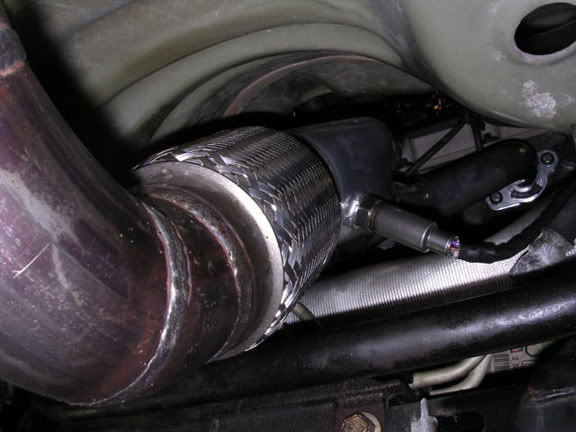
STEP 26: Slip clamp over low side of crossover pipe and insert into rear header. Apply high-temp silicone sealant between mating surfaces.
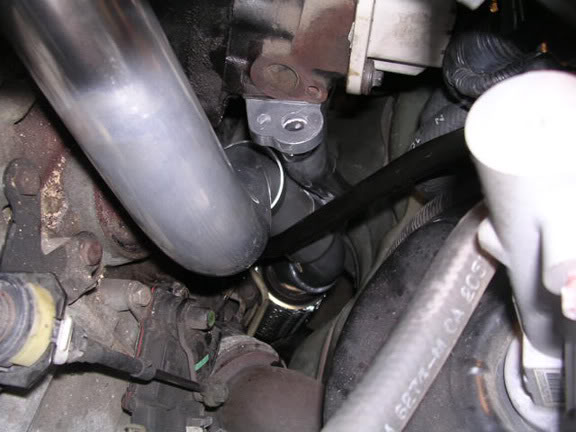
STEP 27: Slip clamp over top side of crossover pipe and insert into front header (sorry, clamp not visible in picture). Apply high-temp silicone sealant between mating surfaces.
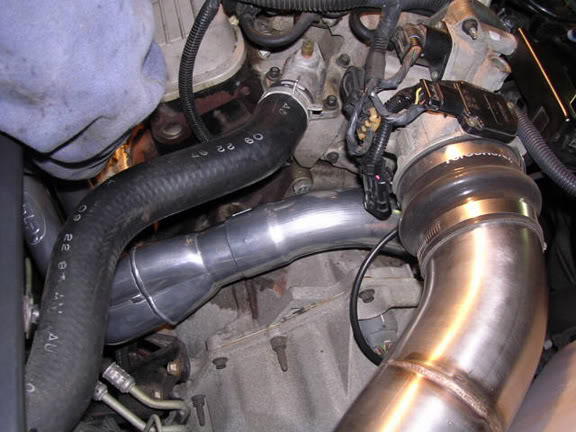
STEP 28: Position and install front header w/gasket. Tighten bolts to 22 lb-ft.

STEP 29: Make sure crossover pipe is oriented so as not to interfere with other engine parts. Tighten pipe clamps "very tight" with ratchet wrench. Wipe away excess silicone.
STEP 30: Reinstall EGR assembly.
STEP 31: Reinstall front heat shield. Shield will need to be bent to avoid contact with the new header.
STEP 32: Reconnect ignition wires and put everything back together.
Before starting the car, wait 2 hours for the RTV to set. Once you start the engine, you're probably going to hear some noise coming from beneath. The clamps used to hold the cat or race pipe together might not form a reliable seal. For best results, take the car to qualified muffler tech to get the joints TIG welded (or do it yourself if you're able). Some shops will do this for as little as $20-$50 if all they need to do is remove the clamps and weld your pieces in place.
Once things are welded up, you should notice an attenuation in noise level. Even then you will probably notice a "tinny" kind of sound that's characteristic of
headers on an OHV engine. It's just something that takes getting used to. If you notice any kind of rumble or drone coming from up front, check the header bolts for tightness. Also make sure there is no leakage from the EGR pipe or the crossover connections. Remember, the clamps need to be
very tight to seal.
With SLP
headers, there's one noise that can get pretty annoying, a "ticking" sound that comes from the braided flex tube under the car. If you're hearing this, you probably have everything else pretty well sealed, as it's not that loud. Still, it can be noticeable, especially with windows rolled down. The only way to deal with this is to wrap the flex tube with header wrap. A good choice is
Thermo-Tec header wrap available at JEGs high performance center. A single 1" x 50' roll sells for $23.99, and is just enough to fully wrap the flex tube. This will lower the noise quite a bit. Use a pipe/hose clamp to hold in place:

A source of noise that may not present itself immediately is the vibration of the metal heat shields under the car... making contact with the header/exhaust pipe or rear O2 sensor during acceleration, or a shield may become loose over time and resonate at a certain RPM, making a metallic buzzing sound. To fix this, you need to locate the vibration and either remove it, add mass to it, or bend it so that the noise goes away.
Apart from the noise issues,
headers do add worth-while performance gain. The power gained will vary with different levels of modification. A stock Riv would probably see very little gain from
headers, but with a 3.4" SC pulley, intake, and rockers, you'll probably be looking at a solid 15 HP gain. An engine with cam or IC could see an extra 20-25 HP. These numbers don't seem like much, but consider that you'll see that power through most of the band, not just up top or down low. Rockers, for example, kick in only from 4-6k RPM.
Headers, on the other hand, give a real power increase in the mid band as well as up top (right where we need it, imo). And unlike N/A cars, you needn't worry about loss of low-end torque. First, we have a gob of it already, especially when using lower SC pulley sizes. If some goes away, it will only help with launching, and your transmission will thank you. Second, any loss in torque is partly a result of lowered boost from the opened exhaust system. This can be remedied by dropping SC pulley size if KR permits.
Best of luck to anyone tackling this project. It's not really as difficult as it looks, even if you don't work on cars all the time. The best part is, you do not need to drop the cradle to install SLP
headers. They just slide right in! Besides the custom welds, things are pretty straightforward.
Would like to thank Tim King at INTENSE and Rob (RivMan) for their technical assistance, and Ed Morad for supplying a few extra parts. Also would like to thank my friend Adam for helping with the install and letting me use his garage and air tools. Please PM or email me with any questions or concerns regarding this write-up.









